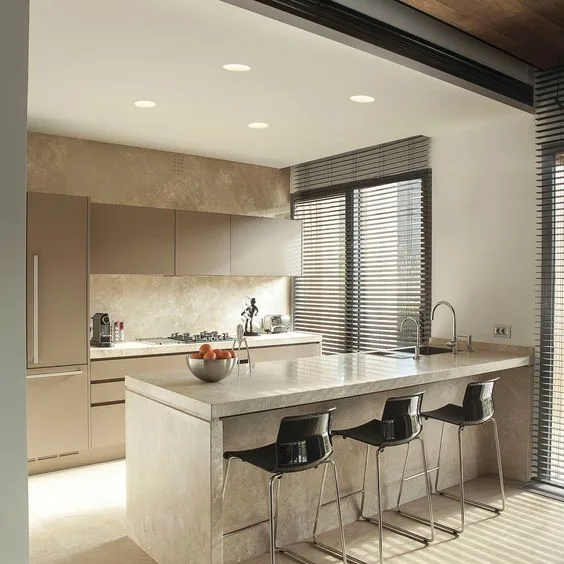LED Downlights for Your Kitchen
The kitchen environment usually requires no space, can provide a clean, inconspicuous light source, and downlights are very suitable, save electricity costs, and will not be obtrusive.
Several types of downlights are available on the market, including LED, halogen, and fluorescent options. LED downlights are especially favored for their energy efficiency and long lifespan, significantly reducing electricity costs compared to their halogen counterparts. Moreover, dimmable LED options allow for adjustable brightness, further enhancing the versatility of these fixtures. LED downlights have a longer service life, so the general kitchen downlights choose LED downlights.
Benefits of Using Downlights in Your Kitchen
Downlights have become increasingly popular in modern kitchen design due to their numerous advantages. One of the primary benefits of these fixtures is their energy efficiency. Compared to traditional lighting solutions, downlights often utilize LED technology, which consumes significantly less energy. This not only helps reduce electricity bills but also contributes to a lower environmental impact. By opting for energy-efficient downlights, homeowners can enjoy enhanced lighting while making a more sustainable choice for the environment.
Moreover, downlights are space-saving fixtures that blend seamlessly into the ceiling. Their recessed design enables them to provide effective illumination without occupying valuable countertops or wall space, making them particularly beneficial in kitchens with limited area. This sleek installation fosters a clean aesthetic, allowing for a more open and organized kitchen environment. Homeowners can achieve a contemporary look while maximizing available space, which is essential in smaller kitchens.
Another significant advantage of downlights is their ability to create layered lighting, essential for practical kitchen activities. By strategically placing multiple downlights, one can enhance task lighting, ensuring areas such as countertops and cooking zones are well-lit. This careful arrangement enhances visibility while preparing meals, ultimately contributing to safety and efficiency. Additionally, downlights can be combined with other lighting solutions, such as pendant lights and under-cabinet lighting, to accentuate the kitchen’s overall ambiance.
In summary, the incorporation of downlights in kitchen spaces not only promotes energy efficiency and spatial optimization but also offers enhanced visibility and an opportunity to elevate the kitchen’s aesthetic appeal. As such, downlights serve as an excellent choice for homeowners seeking to combine functionality with style in their culinary spaces.
Choosing the Right Downlights for Your Kitchen
When selecting downlights for your kitchen, several essential considerations can help optimize both functionality and aesthetics. One of the primary aspects to consider is the wattage and brightness, measured in lumens. Kitchens require adequate illumination for various tasks, from cooking to cleaning. Generally, a lumen level of 300 to 800 per fixture is recommended, depending on the kitchen’s size and layout.
Another crucial factor is color temperature, which influences the ambiance of the space. Color temperature is measured in Kelvins (K); for kitchens, a range between 2700K to 4000K is ideal. A warmer light (2700K – 3000K) creates a cozy atmosphere, while a cooler light (3500K – 4000K) is more conducive to detailed work that requires focus.
The design of the downlight fixtures also plays a vital role in your selection. Consider whether you prefer recessed or surface-mounted downlights, as each can significantly affect the kitchen’s overall design. The aesthetic appeal must harmonize with your kitchen decor, enhancing the space while also providing effective lighting.
Additionally, the beam angle should not be overlooked. A narrow beam angle focuses light on specific areas, while a wider beam angle disperses light more evenly across the space. For kitchens, a combination of both can create task-oriented and overall ambient lighting. This balance can help highlight countertops and islands, facilitating better visibility during meal preparation.
Furthermore, selecting downlights that are compatible with dimmer switches adds versatility, allowing for adjustable brightness to suit various occasions and moods. Lastly, planning the layout and spacing of your downlights is vital. Adequate spacing ensures even light distribution, maximizing coverage without dark corners.
Installation Tips and Maintenance for Kitchen Downlights
When it comes to installing downlights in your kitchen, several methods can be employed, each varying in complexity and requirements. Traditional recessed lighting installation typically involves cutting holes into the ceiling, ensuring appropriate depth for the housing, and securing wiring for electrical connections. If you are considering a DIY installation, it is essential to familiarize yourself with local electrical codes and safety regulations. However, for those unfamiliar with electrical work, hiring a professional electrician is highly advisable. Professionals not only ensure compliance with safety standards but can also help with selecting appropriate lighting solutions catered to your kitchen’s design and layout.
For a DIY project, begin by sketching a layout for your LED downlights, ensuring even light distribution across work surfaces and walkways. Always turn off the electrical supply before making installations and follow manufacturer guidelines when setting up the fixtures. Utilize a stud finder to avoid ceiling joists, and opt for LED downlights for their energy efficiency and longevity. Remember to consider dimmable options to increase versatility in different kitchen settings.
Maintenance of kitchen downlights is equally important for their longevity and performance. Regular cleaning can enhance the aesthetic appeal and light output. Dust and grease can accumulate on the fixtures, diminishing their brightness. A simple damp cloth or a gentle cleaning solution can effectively clean the surfaces while ensuring the fixtures remain intact. Additionally, regularly check the bulbs and replace them as necessary. LED options can last over 15,000 to 50,000 hours depending on usage, making them a cost-effective choice.
In conclusion, proper installation and regular maintenance play pivotal roles in optimizing the functionality and appearance of kitchen downlights. Whether you choose to handle the installation yourself or enlist a professional, the key is to create a safe, efficient, and well-lit environment that suits your cooking and entertaining needs.

